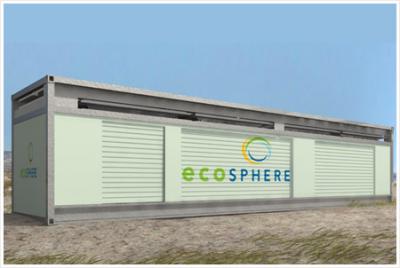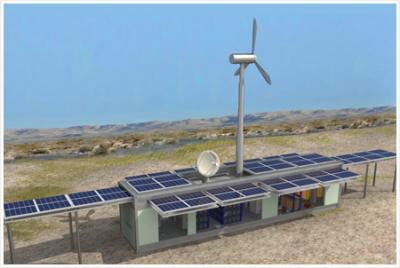Portable, self-contained Ecos LifeLink uses solar power and optional wind turbine to provide clean electricity, convert contaminated ground water to purified drinking water, and deliver wireless Internet connectivity over 30 mile range. Supporting off-grid disaster relief and remote location needs, solution is deployed as two 20 ft Ecos Power Cubes that can provide 16 kW of power. Its 30 gpm water filtration module complies with World Health Organization standards.
Ecosphere Technologies, Inc., a provider of clean air and water technology solutions that solve business and environmental challenges, today debuted Ecos LifeLink, the first in a series of clean energy solutions from its subsidiary, Ecosphere Energy Solutions (EES). The Ecos LifeLink is a portable, self-contained micro-utility that has been designed to use the power of the sun and an optional wind turbine to provide clean electricity, convert the most contaminated ground water to purified drinking water, and deliver wireless Internet connectivity. The system is ideally suited to support off-grid needs including disaster relief and activity in remote locations. A scale model of the Ecos LifeLink will be unveiled at this week’s Cleantech Venture Forum in San Francisco, which brings together more than 600 top investors, companies and thought-leaders for two days of unparalleled networking and cutting edge exchange.
“The debut of our Ecos LifeLink product signals Ecosphere’s new strategic initiative to combine its proven water technologies with renewable energy systems to deliver integrated clean technology solutions to the world,” said Dennis McGuire, CEO of Ecosphere Technologies. “Spurred by increased attention to environmental challenges including extreme weather patterns and population growth, there is unprecedented and growing demand for innovative water filtration and delivery technologies. Ecosphere is uniquely positioned to address and capitalize on that demand by licensing and selling its clean technologies to a broad market, including Fortune 1000 global companies and government agencies at every level.”
Inside the Ecos LifeLink: Designed to meet the growing demand for off-grid water, energy and communications, the Ecos LifeLink solution represents a combination of patent-pending products from EES including the Ecos Power Cube (EPC), a mobile solar generator, and the Ecos Com Cube, a wireless communications platform. Deployed as two 20-foot Power Cubes, the Ecos LifeLink delivers:
- Anytime, Anywhere Power: The foundation of the Ecos LifeLink system is the Ecos Power Cube (EPC). The EPC has a unique patent pending array of stacked solar panels, which when deployed on site provide a photovoltaic surface area of approximately 1000 sq feet. The solar energy system can provide 16KW of clean electricity to power the water filtration processes and the satellite communications system components. An optional wind turbine can also be used to generate additional power.
- Critical Water Supply: The 30 gallons per minute water filtration module is capable of converting arsenic-, bacteria- and waste-laden ground water into water suitable for drinking, cleaning, and cooking. The potable water produced meets the World Health Organization (WHO) standards for clean drinking water.
- Reliable 24/7 Communication: Centered around the Ecos Com Cube, the communications control room is equipped with a satellite communications and electrical power management system that leverages the energy generated from LifeLink’s renewable energy sources to provide electricity and power a full range of wireless VSAT, VOIP and wireless communications capable of handling thousands of phone calls and offering wireless connectivity for a range of up to 30 miles.
“Ecos LifeLink is revolutionary in the fact that it will use only the power of the sun and wind to create and store the energy needed to run water filtration components, pumps, or motors,” said Jean Michel Cousteau, Ecosphere spokesperson, ocean pioneer and leading environmentalist. “LifeLink can be used to provide water and electricity for a small village. Multiple systems could be used throughout a village to power its school, water system, buildings, and communications systems.”

